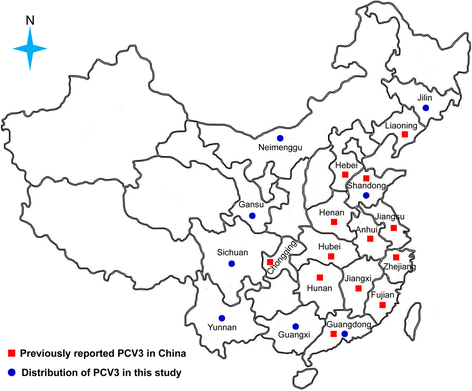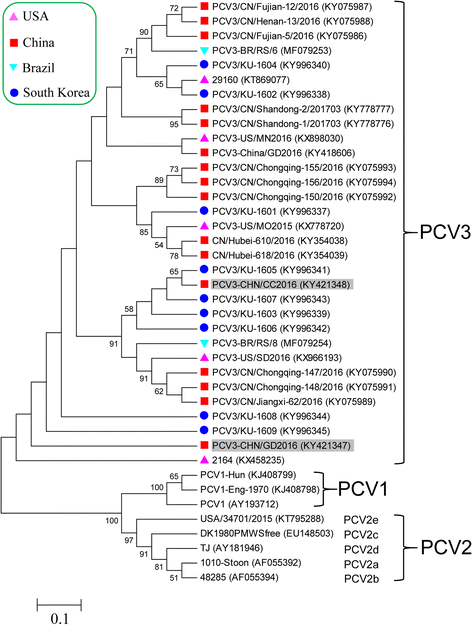Comparative epidemiology of porcine circovirus type 3 in pigs with different clinical presentations
- PMID: 29132394
- PMCID: PMC5683367
- DOI: 10.1186/s12985-017-0892-4
Comparative epidemiology of porcine circovirus type 3 in pigs with different clinical presentations
Abstract
Background: Porcine circovirus type 3 (PCV3), as an emerging circovirus species, was reported to be widely circulating in the United States, China, South Korea and Poland. Previous studies revealed that PCV3 was mainly concentrated in sick animals with respiratory disease, skin disease, reproductive disorders and so on. However, the circulating status of PCV3 in pigs with other clinical presentations (especilly asymptomatic or diarrhea) was not well established.
Findings: In this study, to conduct a comparative epidemiological survey of PCV3, 80 weaned pig serum samples with severe respiratory disease (SRD), 175 weaned pig serum samples with mild respiratory disease (MRD), 216 asymptomatic weaned pig serum samples, 35 diarrheal weaned pig samples and 35 non-diarrheal weaned pig samples were collected from eight provinces of China. Via qPCR testing, PCV3 was circulating in all sampling provinces, with total positive rates varying from 1.04% to 100%. Interestingly, the PCV3-positive rate was significantly higher in weaned pigs with SRD (63.75%, 51/80) than in those weaned pigs with MRD (13.14%, 23/175) and asymptomatic pigs (1.85%, 4/216) (P < 0.01). Similarly, the PCV3-positive rate was significantly higher in diarrheal weaned pigs (17.14%, 6/35) than in non-diarrheal weaned pigs (2.86%, 1/35) (P < 0.05). Moreover, the lower Ct values of qPCR were frequently found in those weaned pigs or fattening pigs with respiratory disease and diarrhea rather than that in asymptomatic pigs. Sequence analysis showed that low genetic diversity existed among those PCV3 sequences collected from pigs with different clinical presentations.
Conclusions: The present study further extends evidence that newly described PCV3 widely circulates in six additional provinces of Southern and Northern China and has high similarity to previously reported isolates. As an emerging virus of swine, although the present case-control study reveals that PCV3 has a potential association with swine respiratory disease and diarrhea, further investigations into the pathogenesis are needed to ascertain the role of PCV3 in swine health.
Keywords: Asymptomatic; Comparative epidemiology; Diarrhea; Porcine circovirus type 3; Respiratory disease.
Conflict of interest statement
Ethics approval and consent to participate
This article does not contain any studies with human participants or animals performed by any of the authors.
Consent for publication
Not applicable.
Competing interest
The authors declare that they have no competing interests.
Publisher’s Note
Springer Nature remains neutral with regard to jurisdictional claims in published maps and institutional affiliations.
Figures



Similar articles
-
Porcine circovirus type 3 (PCV3) infection in grower pigs from a Thai farm suffering from porcine respiratory disease complex (PRDC).Vet Microbiol. 2018 Feb;215:71-76. doi: 10.1016/j.vetmic.2018.01.004. Epub 2018 Jan 27. Vet Microbiol. 2018. PMID: 29426409
-
First detection of porcine circovirus type 3 on commercial pig farms in Poland.Transbound Emerg Dis. 2017 Oct;64(5):1350-1353. doi: 10.1111/tbed.12672. Epub 2017 Jun 26. Transbound Emerg Dis. 2017. PMID: 28649803
-
Molecular detection and phylogenetic analysis of porcine circovirus type 3 in 21 Provinces of China during 2015-2017.Transbound Emerg Dis. 2019 Mar;66(2):1004-1015. doi: 10.1111/tbed.13125. Epub 2019 Feb 7. Transbound Emerg Dis. 2019. PMID: 30637986
-
Novel Porcine Circoviruses in View of Lessons Learned from Porcine Circovirus Type 2-Epidemiology and Threat to Pigs and Other Species.Viruses. 2022 Jan 27;14(2):261. doi: 10.3390/v14020261. Viruses. 2022. PMID: 35215854 Free PMC article. Review.
-
Recent Progress on Epidemiology and Pathobiology of Porcine Circovirus 3.Viruses. 2021 Sep 28;13(10):1944. doi: 10.3390/v13101944. Viruses. 2021. PMID: 34696373 Free PMC article. Review.
Cited by
-
Diversity of respiratory viruses present in nasal swabs under influenza suspicion in respiratory disease cases of weaned pigs.Front Vet Sci. 2022 Oct 19;9:1014475. doi: 10.3389/fvets.2022.1014475. eCollection 2022. Front Vet Sci. 2022. PMID: 36337208 Free PMC article.
-
Pathogenicity and immune modulation of porcine circovirus 3.Front Vet Sci. 2023 Nov 27;10:1280177. doi: 10.3389/fvets.2023.1280177. eCollection 2023. Front Vet Sci. 2023. PMID: 38089706 Free PMC article. Review.
-
Porcine circovirus 3 is highly prevalent in serum and tissues and may persistently infect wild boar (Sus scrofa scrofa).Transbound Emerg Dis. 2019 Jan;66(1):91-101. doi: 10.1111/tbed.12988. Epub 2018 Aug 29. Transbound Emerg Dis. 2019. PMID: 30091190 Free PMC article.
-
Isolation of PCV3 from Perinatal and Reproductive Cases of PCV3-Associated Disease and In Vivo Characterization of PCV3 Replication in CD/CD Growing Pigs.Viruses. 2020 Feb 16;12(2):219. doi: 10.3390/v12020219. Viruses. 2020. PMID: 32079070 Free PMC article.
-
Prevalence of porcine circovirus type 3 in pigs in the southeastern Chinese province of Zhejiang.BMC Vet Res. 2019 Jul 15;15(1):244. doi: 10.1186/s12917-019-1977-7. BMC Vet Res. 2019. PMID: 31307451 Free PMC article.
References
Publication types
MeSH terms
LinkOut - more resources
Full Text Sources
Other Literature Sources
Medical
Research Materials

